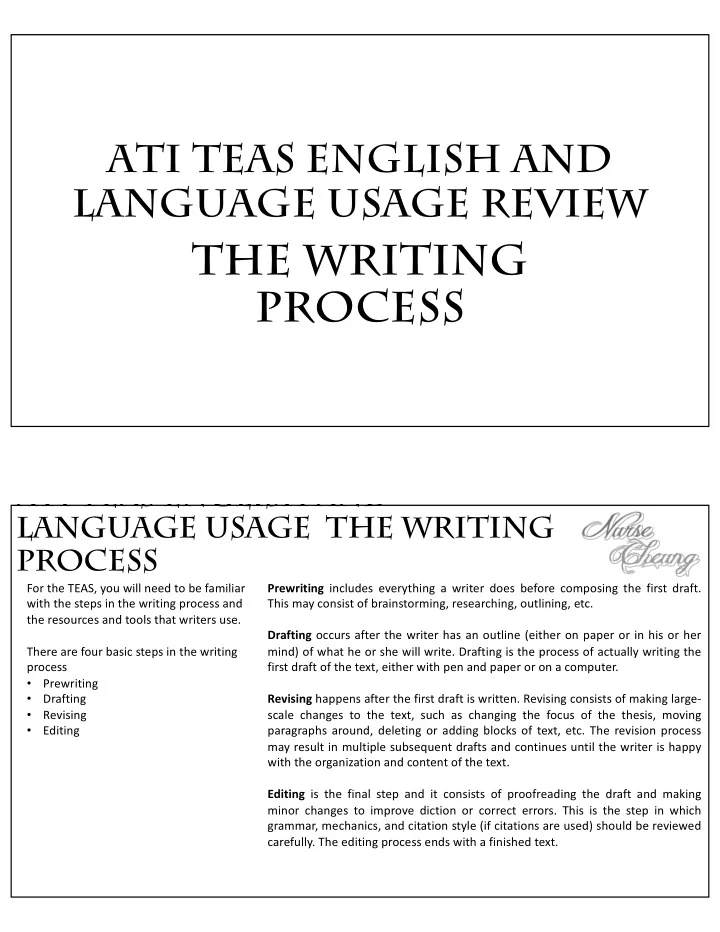

ATI TEAS ENGLISH AND LANGUAGE USAGE REVIEW THE WRITING PROCESS ATI TEAS ENGLISH AND LANGUAGE USAGE THE WRITING PROCESS For the TEAS, you will need to be familiar Prewriting includes everything a writer does before composing the first draft. with the steps in the writing process and This may consist of brainstorming, researching, outlining, etc. the resources and tools that writers use. Drafting occurs after the writer has an outline (either on paper or in his or her There are four basic steps in the writing mind) of what he or she will write. Drafting is the process of actually writing the process first draft of the text, either with pen and paper or on a computer. Prewriting • Drafting Revising happens after the first draft is written. Revising consists of making large- • Revising scale changes to the text, such as changing the focus of the thesis, moving • Editing paragraphs around, deleting or adding blocks of text, etc. The revision process • may result in multiple subsequent drafts and continues until the writer is happy with the organization and content of the text. Editing is the final step and it consists of proofreading the draft and making minor changes to improve diction or correct errors. This is the step in which grammar, mechanics, and citation style (if citations are used) should be reviewed carefully. The editing process ends with a finished text.
ATI TEAS ENGLISH AND LANGUAGE USAGE THE WRITING PROCESS PREWRITING TECHNIQUES Clustering or Mapping : This is a visual diagram made around your topic in the center. Branch As mentioned previously, prewriting includes everything a writer off subtopics and then add detail to each of does before composing the first draft. Here are some common them. Here is an example: techniques a writer uses to gather ideas and organize them before writing the first draft of the text. Brainstorming : Write down as much as you can think of about your topic. Don’t worry about complete sentences or coherence. Just generate ideas. ATI TEAS ENGLISH AND LANGUAGE USAGE THE WRITING PROCESS PREWRITING TECHNIQUES Interviewing : Ask other people questions about the topic. See what interests them about it and what more they would like to know. Stream of Consciousness Writing : Just start writing about your topic and do not stop for a certain length of time (5-10 minutes minimum). It doesn’t matter if you go off topic or write “I don’t know what to write” ten times. Just keep writing. Eventually you will generate ideas about your topic that can be useful to you. Outlining : This should be down once you have at least some idea of what you will write about. An outline organizes your writing and creates a hierarchy that you can use to develop paragraphs or sections of your text. Begin by separating your topic into broad categories and then develop those with subcategories.
ATI TEAS ENGLISH AND LANGUAGE USAGE THE WRITING PROCESS PARAGRAPH ORGANIZATION When drafting and revising a text, writers must pay attention to paragraph organization. Clear, effective writing is organized so that readers can understand the author’s points. The TEAS may ask you about the order of sentences in a paragraph or what could be deleted or added to improve the flow and effectiveness of a paragraph. A basic paragraph structure begins with a topic sentence that tells readers what the paragraph is about. The body of the paragraph will be details about that topic. The final sentence of the paragraph should summarize the information and tie it to the overall thesis of the text. Transitions should be used to move from one topic to the next, either at the end of one paragraph or at the beginning of the next. ATI TEAS ENGLISH AND LANGUAGE USAGE THE WRITING PROCESS CITATIONS 1. Quotations : Anytime you use the exact words from In researched writing, credit should be given to the words and ideas another source, you must enclose the words in of other through citing the source for that material. There are quotation marks and cite the source. several different citation styles (Chicago, APA, MLA, etc.) and you 2. Paraphrases : Anytime you take language from will not be tested on the format of any style. You will, however, be another sources and rephrase it in your own words, expected to know when material needs to include a citation. There you must cite the source. are four basic rules for what material to cite. 3. Summary : If you take an idea from another source and put a condensed version of it in your own words, you must cite the source. 4. Data : If you use facts, information, data, graphics, etc. from another source, you must cite that source. If you use an accepted, well-known fact that could be obtained from many different sources, such as a birthdate of a famous person or the date of a battle, then you do not need to cite a source for that information.
Recommend
More recommend